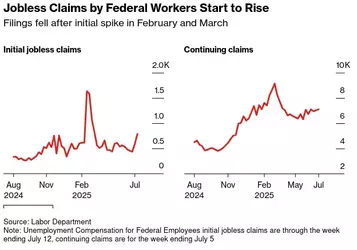 Workers arrive at the US State Department in Washington, DC, on July 11.Photographer: Al Drago/Bloomberg
Workers arrive at the US State Department in Washington, DC, on July 11.Photographer: Al Drago/Bloomberg
The federal government workforce in and around the nation’s capital has shrunk by about 22,100 in the year through May, a new report shows, and that number is poised to mount.
Federal workers across Washington, DC, Maryland and Virginia found themselves particularly vulnerable to the Trump administration’s efforts to reduce government jobs and spending. Maryland saw the steepest decline in its federal workforce, dropping 5.4%, followed by Virginia, according to
a report by the Federal Reserve Bank of Richmond.

Separate data show that applications filed by federal workers for unemployment insurance are climbing again after the US Supreme Court cleared the way for the Trump administration to lay off employees across multiple federal agencies.
There were 787 initial applications for those benefits in the week ended July 12, a second straight increase, Labor Department figures showed Thursday. The data are subject to revision.
The Supreme Court ruled on
July 8 to lift a lower-court order that had blocked 19 federal departments and agencies from slashing their workforces.
On July 14, the Court allowed Trump to resume dismantling the Department of Education, lifting a court order that had required the reinstatement of as many as 1,400 workers.
The “DOGE impact” — referring to the Trump administration’s Department of Government Efficiency — was cited in 286,679 planned layoffs so far this year,
according to outplacement firm Challenger, Gray & Christmas Inc. That included job cuts across the federal workforce and its contractors.
The efforts to curtail some government spending has rippled across
other industries as well. An additional 11,751 job cuts were attributed to the downstream impact such as cutting funding to private nonprofits and affiliated organizations, the firm said.

Since January, unemployment claims in professional, scientific and technical services have topped those in other sectors in each Washington, DC, Maryland and Virginia, the Richmond Fed report said.







